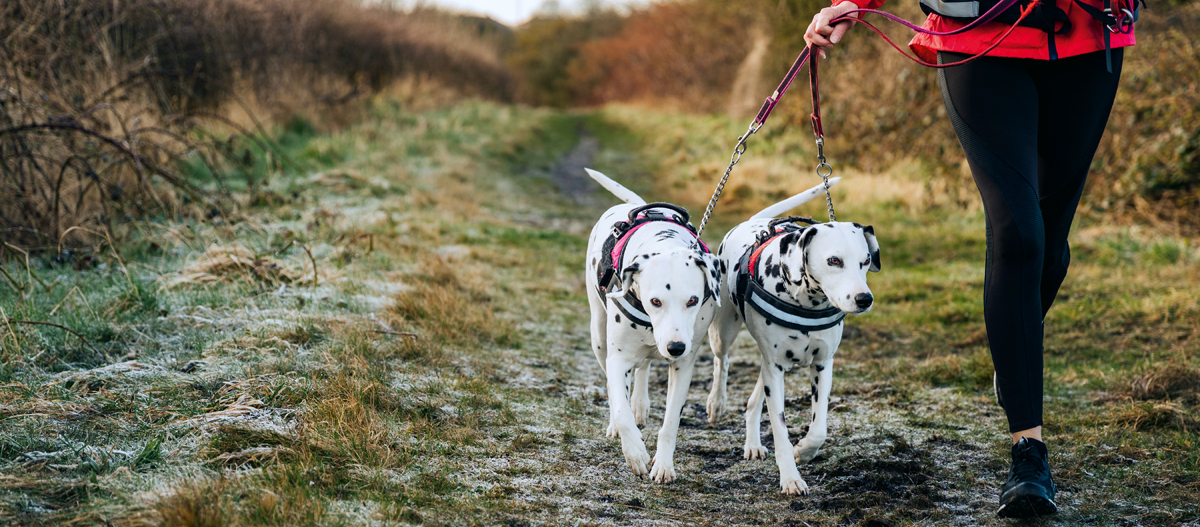Jogging with a Dog: Which Dog Breeds Are Suitable Running Partners
07.10.2022 - Reading time: 4 minutes

Are you an enthusiastic runner and your dog cannot get enough exercise? Then go jogging with your dog! This article will teach you how to make your loyal companion your exercise partner and which things you should remember.
Jogging with a dog: Is that even possible?
Yes, jogging with dogs is a fantastic pastime for the pet and the owner – if the conditions are right. Not every dog is suitable for running and of course you can’t just start running. As with everything, your four-legged friend also needs some training for jogging so that he can get used to the new running situation.
Sport with a dog: From when is it possible to run with a dog?
In principle, you should never go jogging with a puppy. The effort is too much, even for short distances, as neither the condition nor the muscles and bone structure of the growing dog are sufficiently developed. Too much exertion can be detrimental to your dog’s development. Vets therefore recommend taking your dog jogging when it is about one year old, or two years old for large breeds. Old animals are also not suitable partners for running training.

Dogs and jogging: Which dog breeds are suitable as running partners?
There are breeds that, as a rule, are absolutely unsuitable for fast running over longer distances. These include small dogs such as pugs, French bulldogs and dachshunds, as well as large breeds with a heavy body weight such as Saint Bernards or Newfoundlands. It is better not to go jogging with dogs that have a lot of fur, a long back and a high body weight. Real marathon runners, on the other hand, are dog breeds like
These dog breeds need a lot of exercise and can’t wait to run with you.

How do you get a dog used to running?
Before you start jogging, you should first consult your vet and ask him if your dog is suitable as a running partner. If the doctor gives you the green light, you can start training. The prerequisite for relaxed runs is that your dog is obedient and absolutely sure to listen to your commands.
Pay attention to the following points while training:
- Before jogging, your dog should have some time to sniff and do his business.
- Take it slowly at first: tackle shorter distances for the first few weeks and stop every five minutes to begin with. Choose a slow to moderate pace. Gradually increase the pace and distance.
- Reward your four-legged friend either after each section or at the end with a treat and praise him lavishly.
- Pay attention to your companion’s needs: pee and sniff breaks are a must!
- When jogging with the dog, use a longer, looser leash, so that your four-legged friend and you have adequate space.
- If your dog walks next to you without a leash, he should be retrievable at any time.
The weather conditions are also important, if you want to go jogging with your dog: your four-legged friend will not tolerate extreme heat or freezing cold, so only take him along when temperatures are moderate. The surface also plays a role: dogs prefer to run on forest trails or fields. Asphalt is very hard and gets uncomfortably warm in the summer months.
Tip:
Your dog also needs the right equipment for jogging: special jogging leashes and a matching chest harness with soft padding are best for jogging with a dog. Glow-in-the-dark harnesses ensure visibility and safety in the dark.

How can I tell that my dog is tired from its walk?
Your running training should always be adapted to your four-legged friend: adapt your pace and distance to your dog. Warning signs that your dog is overtaxed are
- strong, fast and persistent panting,
- lagging behind of the dog,
- retracted lips,
- refusal of the dog as well as
- limping after a run.
Watch out for the first symptoms of tiredness and stop immediately, if necessary. A dog that is regularly overtaxed will no longer enjoy going out and about with you.


